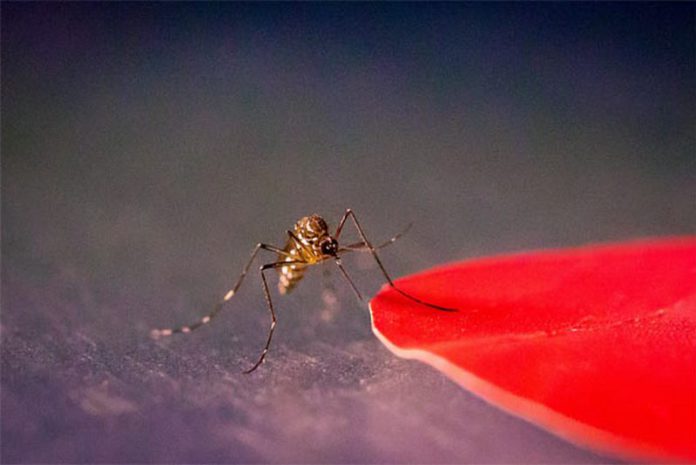Mosquitoes track odours, locate hosts, and find mates visually.
The color of a food resource, such as a flower or warm-blooded host, can be dominated by long wavelengths of the visible light spectrum (green to red for humans) and is likely important for object recognition and localization.
However, little is known about the hues that attract mosquitoes or how odor affects mosquito visual search behaviors.
A new University of Washington-led study shows that after detecting a telltale gas that we exhale, yellow fever mosquitoes (Aedes aegypti) fly toward specific colors, including red, orange, black and cyan, but they ignore other colors, such as green, purple, blue and white.
“Mosquitoes appear to use odors to help them distinguish what is nearby, like a host to bite,” said Professor Jeffrey Riffell, a researcher in the Department of Biology at the University of Washington.
“When they smell specific compounds, like carbon dioxide from our breath, that scent stimulates the eyes to scan for specific colors and other visual patterns, which are associated with a potential host, and head to them.”
In the new experiments, Professor Riffell and his colleagues tracked behavior of female Aedes aegypti, when presented with different types of visual and scent cues.
Like all mosquito species, only females drink blood, and bites from Aedes aegypti can transmit dengue, yellow fever, chikungunya and Zika.
The researchers tracked individual mosquitoes in miniature test chambers, into which they sprayed specific odors and presented different types of visual patterns – such as a colored dot or a tasty human hand.
Without any odor stimulus, mosquitoes largely ignored a dot at the bottom of the chamber, regardless of color.
After a spritz of carbon dioxide into the chamber, mosquitos continued to ignore the dot if it was green, blue or purple in color. But if the dot was red, orange, black or cyan, mosquitoes would fly toward it.
Humans can’t smell carbon dioxide, which is the gas we and other animals exhale with each breath. Mosquitoes can.
Past research showed that smelling carbon dioxide boosts female mosquitoes’ activity level – searching the space around them, presumably for a host.
The colored-dot experiments revealed that after smelling carbon dioxide, these mosquitoes’ eyes prefer certain wavelengths in the visual spectrum. It’s similar to what might happen when humans smell something good.
“Imagine you’re on a sidewalk and you smell pie crust and cinnamon,” Professor Riffell said.
“That’s probably a sign that there’s a bakery nearby, and you might start looking around for it.”
“Here, we started to learn what visual elements that mosquitoes are looking for after smelling their own version of a bakery.”
Most humans have true color vision: We see different wavelengths of light as distinct colors: 650 nm shows up as red, while 450 nm wavelengths look blue, for example.
The scientists do not know whether mosquitoes perceive colors the same way that our eyes do.
But most of the colors the mosquitoes prefer after smelling carbon dioxide – orange, red and black – correspond to longer wavelengths of light.
Human skin, regardless of pigmentation, also gives off a long-wavelength signal in the red-orange range.
When the study authors repeated the chamber experiments with human skintone pigmentation cards – or a researcher’s bare hand – mosquitoes again flew toward the visual stimulus only after carbon dioxide was sprayed into the chamber.
If the researchers used filters to remove long-wavelength signals, or had the researcher wear a green-colored glove, then carbon dioxide-primed mosquitoes no longer flew toward the stimulus.
Genes determine the preference of these females for red-orange colors. Mosquitoes with a mutant copy of a gene needed to smell carbon dioxide no longer showed a color preference in the test chamber.
Another strain of mutant mosquitoes, with a change related to vision so they could no longer see long wavelengths of light, were more color-blind in the presence of carbon dioxide.
“These experiments lay out the first steps mosquitoes use to find hosts,” Professor Riffell said.
The team’s results were published in the journal Nature Communications.

